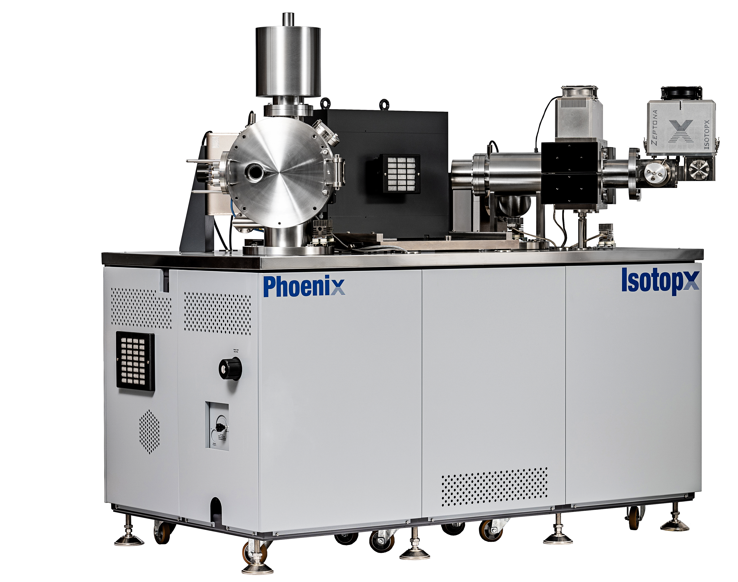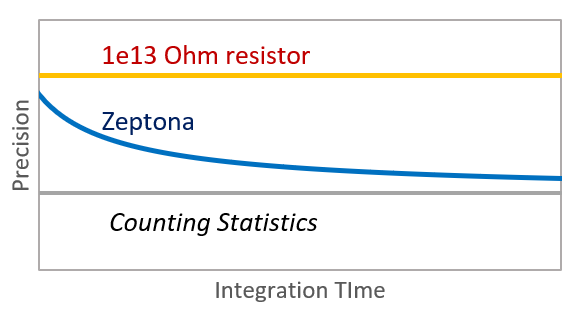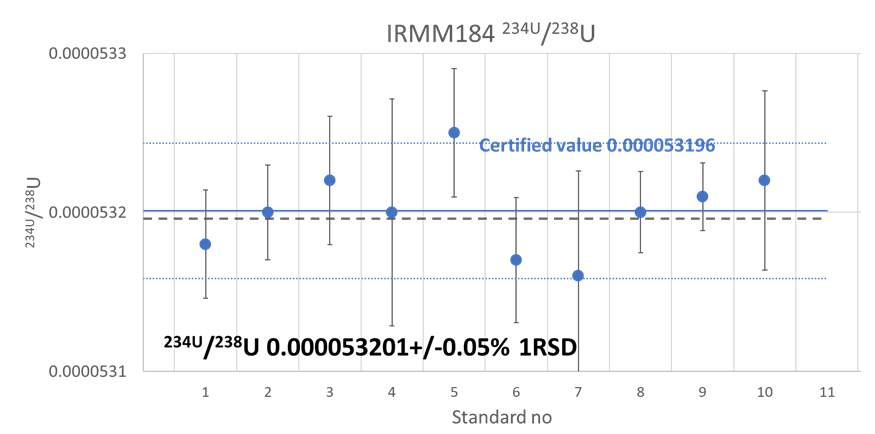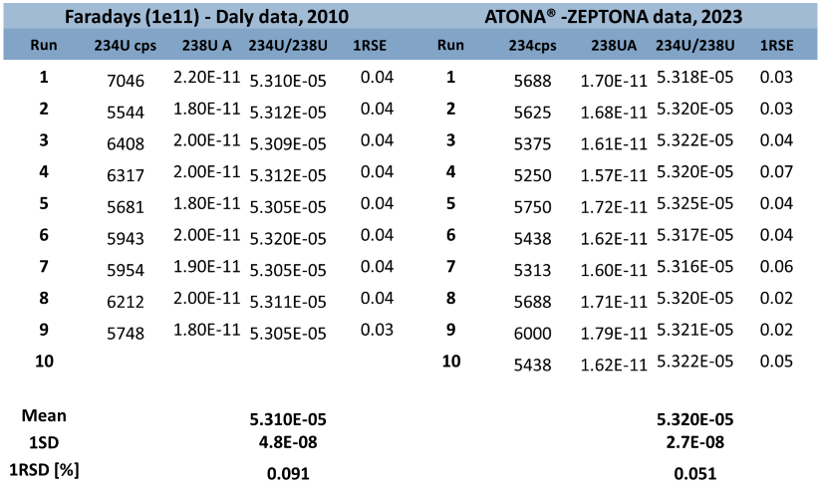Zenon Palacz, Shaun Yardley, Matt Hockley, Steve Guilfoyle
Introduction
High precision determination of 234U / 238U is important in many geological research applications. The typically low abundance of 234U (234U / 238U = 0.000053196 in IRMM184) in these applications has necessitated the use of ion counters for this isotope, while the much larger 238U must be measured on a Faraday detector.
The intermediate abundance 235U (235U / 238U = 0.007263) is used to calibrate the ion counter/Faraday gain. An example of this is given in Isotopx Application Brief G20111r2, which includes a discussion of the difficulty that accounting for ion counter effects such as gain drift and deadtime present to this measurement, and the consequences this has on the resulting data. The development of the Isotopx ATONA and Zeptona amplifier systems allows the possibility of making this measurement on an “all Faraday” detector system, avoiding the difficulties inherent in the use of ion counting.

A Phoenix TIMS equipped with a standard 9 ATONA amplifier Faraday main array and a Zeptona amplifier Faraday behind a WARP filter was used for this study. A detailed account the properties of these detector systems is given in Isotopx Technical Notes TN30182 and TN2102. The very low noise, stable baseline offset, fast response time and excellent gain stability of the ATONA and Zeptona amplifiers are crucial to this measurement.
Additionally, the positioning of the Zeptona Faraday behind the WARP abundance sensitivity filter is required for accurate 234U/238U isotopic ratios.
Method
2 μg of IRMM184 was loaded onto the outer filament of a Re triple filament assembly. The centre filament was heated to 4.5 A and a 187Re beam was focussed on. The centre filament was heated until an 80 mV 187Re beam was obtained. The side filament was then heated to 1.8 A and the 238U beam was focussed on. Focussing and heating of the side filament was continued until a stable 2 V 238U (15 mV 235U, 0.1 mV 234U) beam was obtained, at which point the analysis was started.
Mass spectrometry and amplifier optimisation
Immediately prior to analysis an Electronic Base Line (EBL) method was run for 1 hour. This is sufficient to determine the baseline of the Zeptona Faraday to ~0.016 μV (1 CPS), which gives an offset of less than 0.02% on the ~0.1 mV (6,000 CPS) 234U signal. ATONA baselines are determined to ~ 0.08 μV (5 CPS) during the EBL, which results in negligible offset on the 15 mV (900 kCPS) 235U and 2 V 238U (126 MCPS) beams.
A unique feature of the ATONA and Zeptona amplifiers was exploited in this study – amplifier noise decreases with integration time more than 3 times more quickly than both resistor-based amplifiers and shot noise of the beam. This leads to two subtle but important consequences:
1) High precision baselines can be achieved far more quickly than with resistor amplifiers.
2) The precision of a measurement improves with increasing integration time for a given total analysis time, e.g. 10 x 30 s integrations will yield better standard errors than 30 x 10 s integration. This effect can be significant with small beams. Resistor amplifiers do not have this property.
Figure 1 provides an illustration of the practical effect of the second point. The theoretical precision obtainable on a 6,000 CPS beam over a fixed total measurement period but with differing integration times was calculated for 1e13 Ohm resistor and Zeptona amplifiers and is compared to counting statistics. The precision obtained with resistor amplifiers is constant with integration time, while ATONA/Zeptona amplifiers asymptotically approach counting statistics with increasing integration time.

These properties make the ATONA and Zeptona ideal for measurement of very small ion beams, since integration times can be optimised for a particular application, favouring either low noise or high numbers of individual integrations as the application demands. A brief overview of how this may be done is given in Isotopx Technical Note AN22_01.
A two-sequence method was used as detailed in Figure 2. The ratio of interest, 234U/238U and the fractionation correcting ratio, 235U/238U were measured in sequence 1. The 235U/238U from sequences 1 and 2 were used for gain correction of the Zeptona.

Note that the sequence 1 integration time is 30 s, while for sequence 2 it is just 5 s. These integration times were chosen such that amplifier noise was not a significant contribution to total uncertainty in the measurement of the precision limiting 234U (Zeptona) and 235U (ATONA) in S1, and 235U (Zeptona) in S2.
Note also that shorter integration times are used for the 235U in S2 than S1 due to the required amplifier noise for a given beam size being reached faster with the Zeptona than the ATONA. The 238U was sufficiently large that it was not necessary to consider during optimisation – amplifier noise was negligible for any reasonable integration time.
Results
The results of 10 consecutive analyses of 234U/238U are detailed in Table 1. Average internal precision of the gain and fractionation corrected 234U/238U ratio is approaching counting statistics at 0.04% (1 RSE), with the external precision of the 10 runs being 0.05% (1 RSD). The accuracy of the 234U/238U is 0.01%, well within the uncertainty of the measurement.
The gain of the Zeptona Faraday was determined to better than 0.01% (1 RSE) for individual filaments and as such will have only a minor contribution to the final 234U/238U precision. The variation of the gains was 0.1% (1 RSD) across the 10 consecutive filaments. This difference is attributed to minor variations in transmission through the WARP abundance sensitivity filter but is notably more than an order of magnitude less than observed when using the ion counting Daly behind the WARP.


The data presented here can be compared with that in Isotopx Application Brief G20111r2 (summarised in the table above), which details data obtained from analysis of 1 μg of the same uranium standard run using a similar method, except the ion counting Daly is used instead of the Zeptona Faraday, 1e11 resistor Faradays are used instead of ATONA Faradays, and no integration time optimisation is performed.
The internal precision of the data is comparable, while the external precision is 0.09%, almost 2 times worse than with the current method. The precision of the fractionation correcting 235U/238U is also improved by a factor of 2. This improvement is attributed to:
- Far superior filament to filament gain stability of the Zeptona (0.1%) compared to the ion counting Daly (3%)
- Approximately 20 times improvement of the amplifier noise at the integration times used on the 235U beam (which is the limiting beam for gain calibration and fractionation correction) with ATONA/Zeptona compared to the 1e11 ohm resistors
- The lack of linearity/deadtime effects with the Zeptona
- Better baseline determination than is possible with resistor-based systems
- Optimisation of integration time by sequence.
Conclusions
The 234U/238U of IRMM184 natural uranium standard was measured using an Isotopx Phoenix TIMS equipped with a standard array of 9 ATONA Faraday cups plus an ultra-low noise Zeptona rear Faraday situated behind a WARP abundance sensitivity filter. The reproducibility of the obtained data is improved by almost a factor of two compared to data obtained in a similar way using a resistor amplifier main array of Faraday cups and an ion counting Daly, which has until now represented the gold standard for these measurements.
This demonstrates the possibility of not only obtaining precise and accurate data with beams of less than 10,000 CPS using the Zeptona Faraday, but that it is possible though careful method optimisation to exceed the performance of ion counting systems at these beam intensities.
Additionally, the greater simplicity, robustness and dynamic range of the Zeptona Faraday make this data far easier to obtain routinely.
Download Application Note
Download the complete Application Note using the link below:
Measurement of IRMM184 using ATONA and Zeptona with Phoenix TIMS